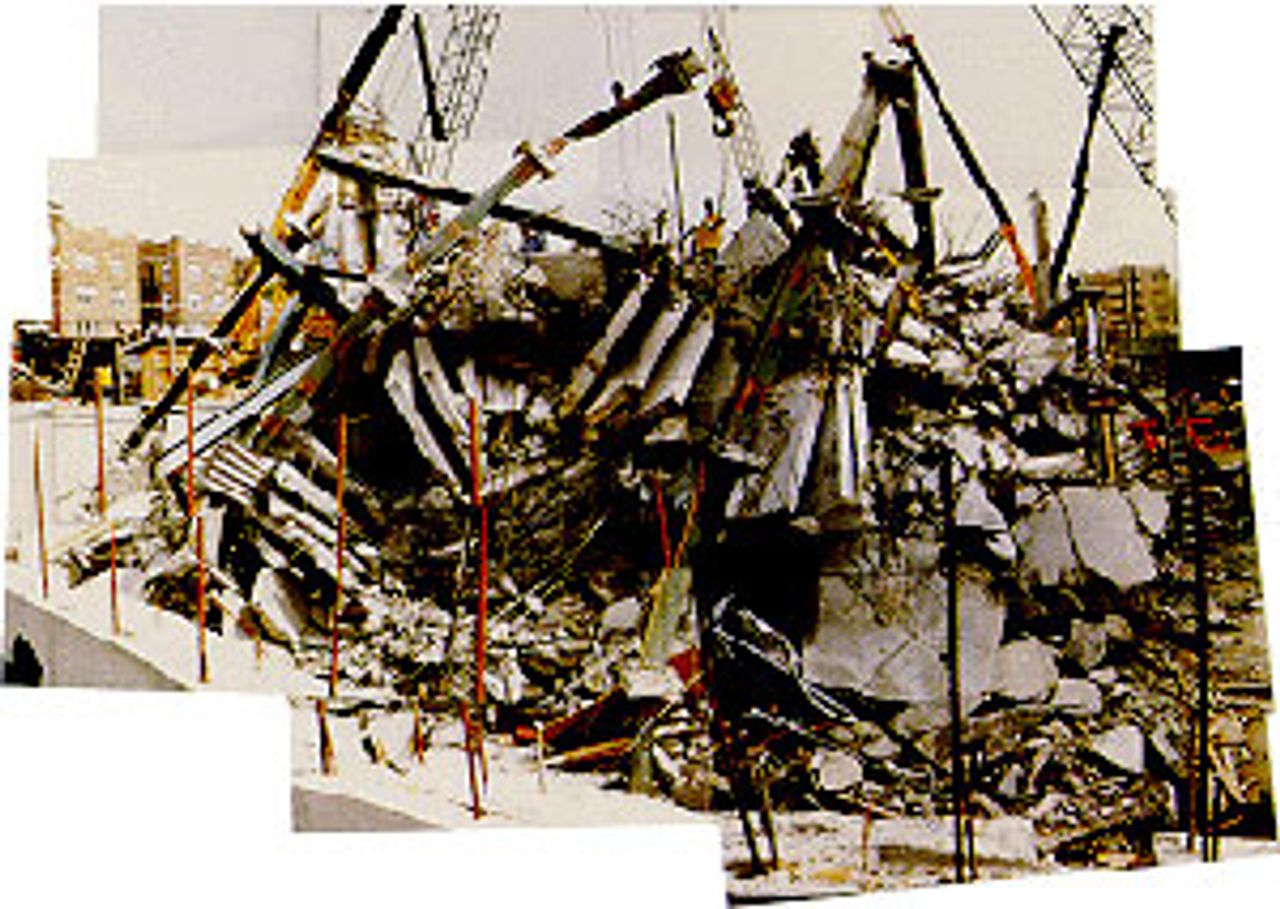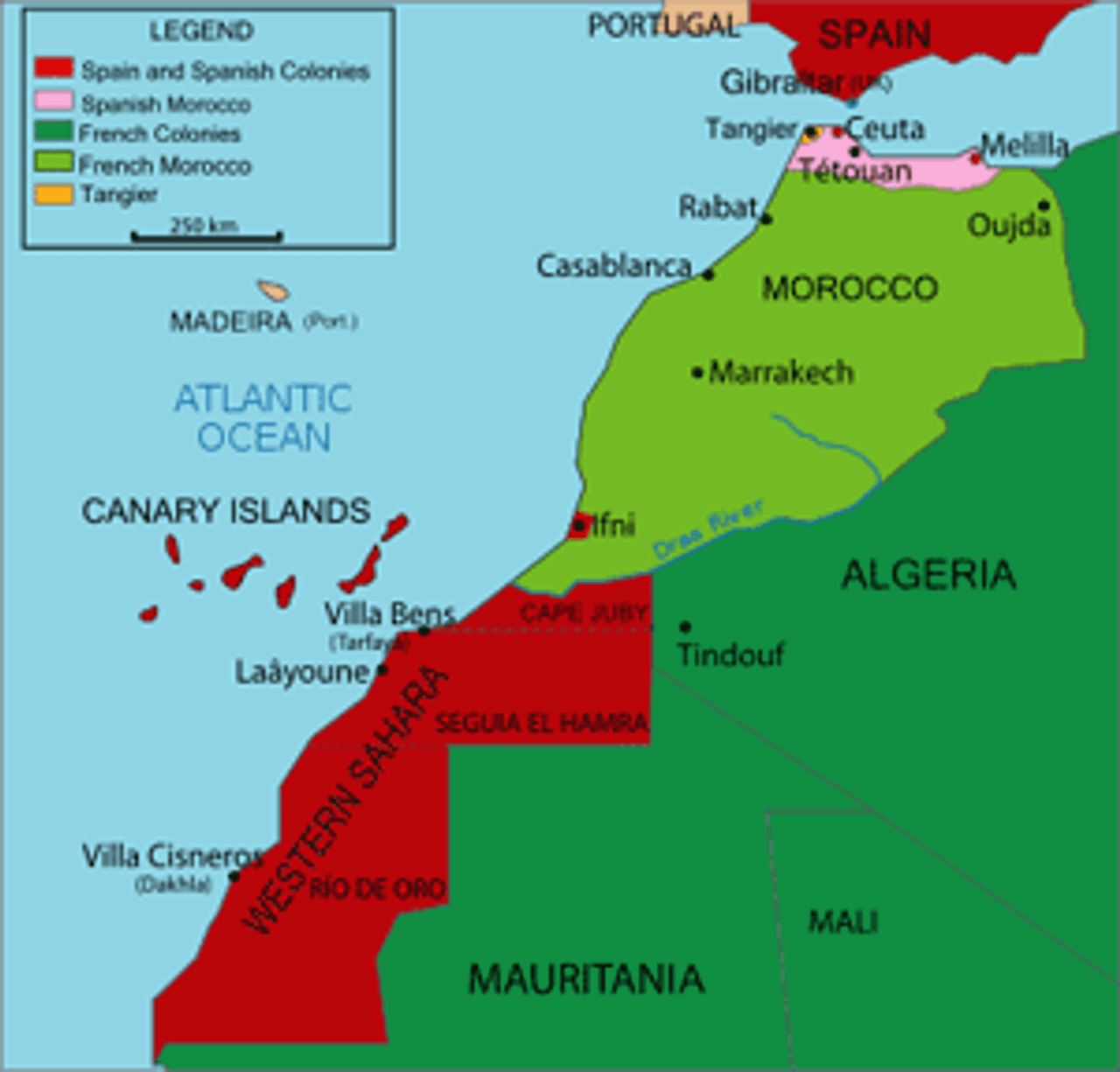This Week in History provides brief synopses of important historical events whose anniversaries fall this week.
25 Years Ago | 50 Years Ago | 75 Years Ago | 100 Years Ago
25 years ago: 28 workers killed in US construction collapse
 A composite photo of the 1987 collapse
A composite photo of the 1987 collapseBridgeport, Connecticut was the scene of the worst construction disaster in the state’s history on April 23, 1987. Twenty-eight construction workers died as massive concrete slabs suddenly collapsed, leaving the workers buried under tons of twisted steel and broken concrete.
The construction site, known as L’Ambiance Plaza, was to have been a sixteen-story apartment complex with three subterranean parking structures. The technique known as “lift-slab” construction was being used to set in place the 9th-11th stories at the time of the collapse.
“Lift-slab” construction, in which the concrete slabs for all floors are first poured on the ground with bond breakers in between, then cured and hoisted into place in “packets” with hydraulic jacks placed atop steel beams, is recognized by civil engineers as a cost-cutting method which can be stable once completed but poses significant dangers to the workers involved in the construction process.
The L’Ambiance Plaza collapse was the worst lift-slab accident on record and resulted in a temporary ban on the technique in Connecticut. It has been largely discontinued in the US.
Although there were numerous investigations launched into the disaster, there are still only theories on the cause of the collapse. More than twenty separate parties were found guilty of “widespread negligence, carelessness, sloppy practices, and complacency.” However, an unusually rapid $41 million legal settlement was concluded by a two-judge panel, preventing any conclusive determination of the causes of the collapse and no assignment of responsibility.
50 years ago: Ranger IV crash lands on Moon
 Ranger IV
Ranger IVOn April 26, 1962, the US space vessel Ranger IV crash landed on the far side of the Moon after a voyage from Cape Canaveral spanning 231,486 miles in 64 hours. The first US craft to reach the Moon did so nearly three years after the Soviet Union had successfully landed the Lunik II, the first manmade object to reach a celestial body, which was then quickly followed by Lunik III landing on the dark side of the moon. Nine previous NASA (National Aeronautics and Space Administration) attempts to land on, orbit, or fly near the moon had all ended in failure.
US scientists salvaged some prestige simply by reaching the Moon, but the intention had been to land the object on the bright side and not the far side. The failure of an on-board computer and battery prevented scientists at the California Institute of Technology monitoring the flight from adjusting Ranger IV’s trajectory and from separating its 83-pound flight capsule from the 730-pound craft as planned. When it reached 900 miles from the lunar surface, it was captured by the Moon’s gravitational pull and hurtled in orbit toward a dark side crash. Television cameras, seismographic equipment, and other scientific instruments were destroyed by the force of the craft’s 5,963 mile per hour impact near the lunar equator.
On April 24, the Soviet Union launched the unmanned Cosmos III, which began orbiting the earth every 93 minutes. It joined two other Cosmos satellites in scientific explorations of space around earth. On April 25, NASA announced a second test for its new Saturn rockets, which were designed to carry a heavier payload into space than that which Soviet rockets were then capable of transporting.
75 years ago: The bombing of Guernica
 Picasso's painting, "Guernica"
Picasso's painting, "Guernica"During the afternoon and early evening of Monday, April 26, 1937, the German and Italian air forces destroyed the Spanish town of Guernica in a raid lasting three hours. The war crime was ordered by the Spanish nationalist military leadership and carried out by the Condor Legion of the German Luftwaffe and the Italian Aviazione Legionaria. Designed to kill or maim as many civilians as possible, Operation Rugen was deliberately chosen for a Monday afternoon when the weekly town market would be at its most crowded. Guernica, in the Basque country where revolutionary sentiment among workers was deep, was defenseless from the bombers, which could fly as low as 600 feet.
The airplanes made repeated raids, refueling and returning to drop more bombs. Waves of explosive, fragmentary, and incendiary devices were dumped on the town. In total, 31 tons of munitions were dropped between 4:30 in the afternoon and 7:30 in the evening. In the aftermath of the raid, survivors spoke of the air filled with the screams of those in their death throes and the hundreds injured. Civilians fleeing the carnage in the fields surrounding the town were strafed by fighter planes. Human and animal body parts littered the market place and town center, a horror soon immortalized by Pablo Picasso’s Guernica.
Guernica was effectively wiped off the map. From a population of 5,000 some 1,700 residents were killed and a further 800 injured. Three quarters of the buildings were razed to the ground. Farms four miles away were flattened.
The savage and barbarous attack was a deliberate attempt to terrorize and intimidate the workers of Republican Spain. Spanish nationalist general Emilio Mola had spoken of destroying the industry of Barcelona and Bilbao in order to cleanse the country. In other words, the Nationalists would endeavor to destroy the industrial proletariat. As the historian Paul Preston has recently written in Spanish Holocaust, the Nationalist forces had launched a scorched earth policy during their rapid advance through Spain, most notably in Badajoz, where many hundreds of revolutionary workers were machine-gunned to death in the city’s bullring.
The fascist governments of Berlin and Rome were only too glad to assist Franco in his “cleansing” of the Spanish population, as both a geo-political necessity and as a test of their military command, new military technology and fighting forces. At his trial for war crimes at Nuremberg, the leading Nazi Hermann Goering would tell the tribunal that he had urged Hitler to send German forces to stem socialism in the Iberian theatre and to test out the Luftwaffe.
100 years ago: French crackdown in Morocco
 Morocco in 1912
Morocco in 1912This week in 1912 French authorities launched a crackdown in Fez, Morocco, following the suppression of a popular revolt the previous week. French troops guarded the city gates, restricting access, and arresting anyone suspected of participating in the revolt. French deaths incurred during the uprising totaled 68, including 15 officers, 40 soldiers, and 13 civilians.
The revolt broke out less than a month after Morocco had become a French protectorate under extremely unfavorable terms. The agreement, signed with the sultan, granted the French the right to dispatch troops to any part of Morocco and control all of the country’s foreign transactions, and concentrated power in the hands of a protectorate government.
While it began with native troops turning their guns on the French, the revolt rapidly spread. The London Times commented that there was “a growing consensus of testimony that the Fez revolt was the result of a popular movement produced in part by the native belief that the Sultan was practically in the hands of the French.”
Historian Edmund Burke has written that the revolt was fueled by the discontent of the laboring masses over price rises, increasingly difficult living conditions, the hostility of religious elements to the removal of their tax-free status, and the recognition amongst merchants that they would not receive contracts on favorable terms. However, the uprising was directed by local elites into the blind alley of communalism. Fez’s Jewish quarter was ransacked, with 45 people killed. French authorities had previously disarmed the Jewish population.
